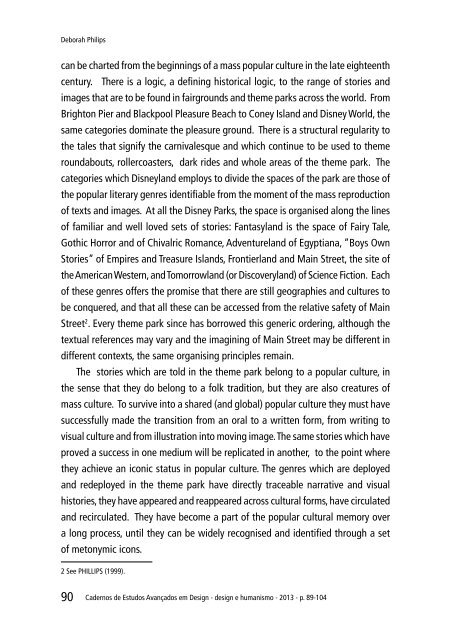o_19po8js951tvs1r0t1r8s4bb1vpla.pdf
You also want an ePaper? Increase the reach of your titles
YUMPU automatically turns print PDFs into web optimized ePapers that Google loves.
Deborah Philips<br />
can be charted from the beginnings of a mass popular culture in the late eighteenth<br />
century. There is a logic, a defining historical logic, to the range of stories and<br />
images that are to be found in fairgrounds and theme parks across the world. From<br />
Brighton Pier and Blackpool Pleasure Beach to Coney Island and Disney World, the<br />
same categories dominate the pleasure ground. There is a structural regularity to<br />
the tales that signify the carnivalesque and which continue to be used to theme<br />
roundabouts, rollercoasters, dark rides and whole areas of the theme park. The<br />
categories which Disneyland employs to divide the spaces of the park are those of<br />
the popular literary genres identifiable from the moment of the mass reproduction<br />
of texts and images. At all the Disney Parks, the space is organised along the lines<br />
of familiar and well loved sets of stories: Fantasyland is the space of Fairy Tale,<br />
Gothic Horror and of Chivalric Romance, Adventureland of Egyptiana, “Boys Own<br />
Stories” of Empires and Treasure Islands, Frontierland and Main Street, the site of<br />
the American Western, and Tomorrowland (or Discoveryland) of Science Fiction. Each<br />
of these genres offers the promise that there are still geographies and cultures to<br />
be conquered, and that all these can be accessed from the relative safety of Main<br />
Street 2 . Every theme park since has borrowed this generic ordering, although the<br />
textual references may vary and the imagining of Main Street may be different in<br />
different contexts, the same organising principles remain.<br />
The stories which are told in the theme park belong to a popular culture, in<br />
the sense that they do belong to a folk tradition, but they are also creatures of<br />
mass culture. To survive into a shared (and global) popular culture they must have<br />
successfully made the transition from an oral to a written form, from writing to<br />
visual culture and from illustration into moving image. The same stories which have<br />
proved a success in one medium will be replicated in another, to the point where<br />
they achieve an iconic status in popular culture. The genres which are deployed<br />
and redeployed in the theme park have directly traceable narrative and visual<br />
histories, they have appeared and reappeared across cultural forms, have circulated<br />
and recirculated. They have become a part of the popular cultural memory over<br />
a long process, until they can be widely recognised and identified through a set<br />
of metonymic icons.<br />
2 See PHILLIPS (1999).<br />
90<br />
Cadernos de Estudos Avançados em Design - design e humanismo - 2013 - p. 89-104



